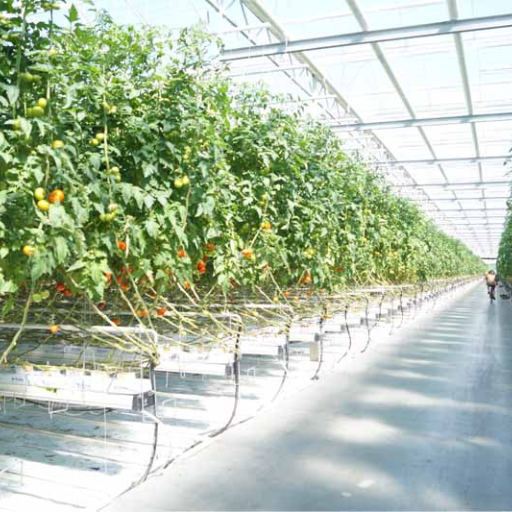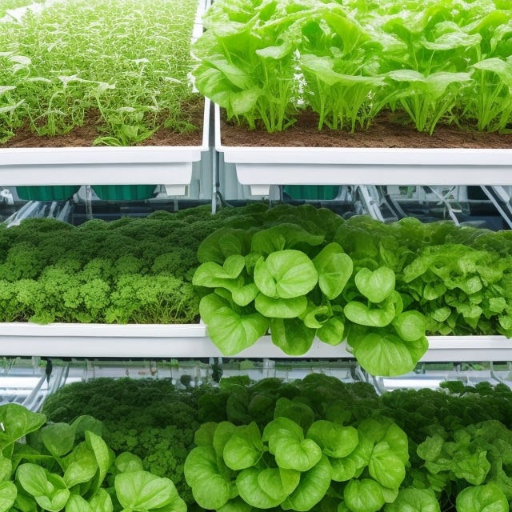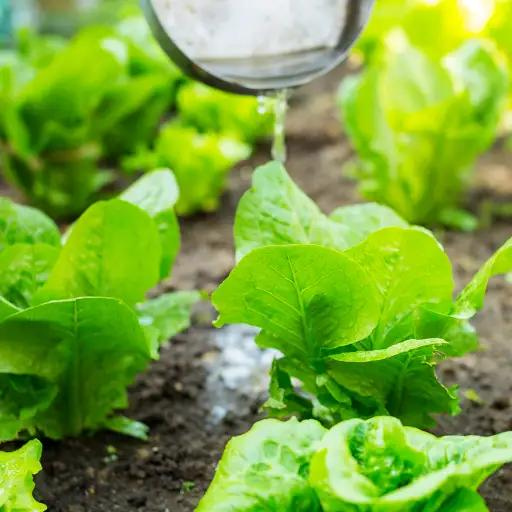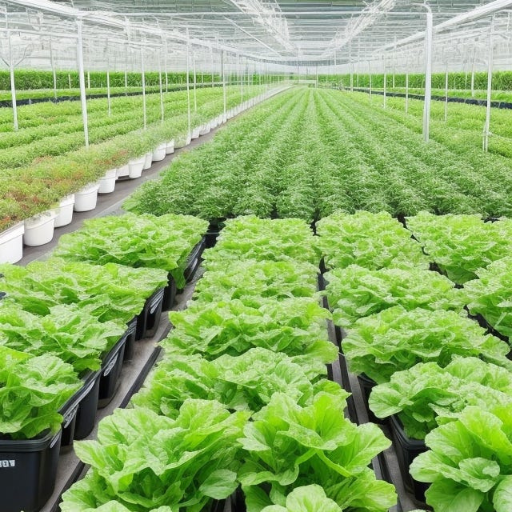In the quest for sustainable and efficient farming practices, hydroponics has emerged as a powerful method to cultivate plants without soil, using nutrient-rich water solutions. This approach not only conserves water but also allows for faster and more controlled plant growth. Specifically, the use of organic hydroponic nutrients has garnered significant attention among growers seeking to combine the benefits of hydroponics with environmentally friendly practices. This article delves into the essentials of using organic hydroponic nutrients, offering insights into their advantages, how they can be optimally used, and the impact they have on plant health and yield. Whether you’re a seasoned hydroponic farmer or a curious beginner, this guide aims to provide valuable information to enhance your plant growth and achieve bountiful harvests.
What Are Organic Hydroponic Nutrients?

Understanding Organic Nutrients vs. Inorganic Nutrients
Organic nutrients come from natural sources such as plants and animals and undergo slight processing to preserve their natural nature. Such nutrients include compost, bone meal, fish emulsion, and seaweed extracts among others. However, inorganic nutrients are synthesized from chemicals hence are more available to plants due to better accuracy in formulation. Despite the fact that this process provides vegetation with an immediate nutrient source through these fertilizers but it builds soil structure and promotes useful microorganisms that will be present in the soil for a long time. When using organic nutrients in hydroponics, therefore, clogging must be managed against while ensuring sustained supply of plant foods.
Key Components of Organic Hydroponic Nutrients
For optimum plant growth, organic hydroponic nutrients ought to have several essential elements:
- Nitrogen (N): It is very important for leaf and stem development which can be gotten organically from fish emulsion, blood meal or legume-based compost.
- Phosphorus (P): This element is needed for root formation and blooming; it can be sourced from bat guano or bone meal.
- Potassium (K): It is vital for overall well-being of the crop and resistance to diseases in which case kelp extract, wood ash or even composted banana peels can source it organically.
- Micronutrients: Such elements are vital for different physiological processes within plants such as calcium from limestone; magnesium through Epsom salts; sulfur gotten via gypsum.
- Trace Minerals: These are minerals like zinc, iron, manganese and copper usually derived from rock dusts ,seaweed extracts or even organic amendments .
Therefore all these components have to be well balanced in order to obtain healthy strong plants in an organic hydroponic system.
Benefits of Using Organic Nutrients in Hydroponics
There are many reasons why one would use organic hydroponic nutrient systems when growing plants in this manner. The main of these is improving the quality and taste of crops grown. These nutrients release essential elements slowly into soil hence enhancing their rich taste and nutritional value. Additionally, organic nutrients foster the microbial life within the growing media by encouraging beneficial microorganisms necessary for plant health and resistance to diseases.
This makes organic hydroponic systems environmentally friendly as they rely on natural, renewable nutrient sources that do not have to depend on synthetic chemicals that may damage ecosystems. Organic methods however can be used to enhance soil fertility when integrated with soil based gardening in order to sustain agriculture for a long time. Finally, using organic nutrients also supports eco-friendly and health-conscious consumer preferences which may further improve product marketability and build consumer trust among such products’ consumers.
How Do You Use Organic Nutrients in a Hydroponic System?
Preparing the Organic Nutrient Solution.
To prepare organic nutrient solution for hydroponic system, start by choosing high quality organic nutrients such as those derived from compost teas or liquid seaweeds. Follow the manufacturer’s instruction on how to dilute the nutrients as concentration levels can vary. In most cases, this entails mixing a specific amount of the product with water. Ensure necessary oxygen levels are attained in the solution to stimulate helpful microorganism growth by aerating it using an air pump and air stones. With regard to nutrient availability and plant uptake, monitor and adjust pH of nutrient solutions regularly, with a target range of 5.5-6.5 being recommended.
Step-by-Step Guide to Adding Organic Nutrients to Your System
- Prepare Your Nutrient Solution: Follow the instructions on the organic nutrient product to create the solution, which often entails diluting them in water up to certain recommended quantities.
- Aerate the Solution: Use an air pump and air stone to aerate your solution since sufficient oxygen supply into your nutrient solution is vital for beneficial microbial health.
- Adjust the pH: Take a digital pH meter and measure pH of your nutrient solution adjusting it within optimum range from 5.5 – 6.5 because at that point all key elements will be available for plant nutrition.
- Introduce the Solution to Your System: Gently pour your prepared and aerated nutrient solution into your hydroponic system’s reservoir while ensuring its even spread so as not cause any concentration gradients.
- Monitor and Maintain: Always check if there is enough nutrients and ph level in your solution diluted with water. Fresh supplies should be added when necessary while residues should not accumulate inside channels or any other places where they could block absorption of nutrients.
By doing this you will successfully incorporate organic nutrients into hydroponic systems that promote sustainable agriculture through healthy plant growth too.
Maintaining Correct Nutrient Balance
It is important however that you maintain appropriate balance of nutrients in your hydroponic system for optimum plant growth. Here are a few main points based on the current best practices:
- Consistent Monitoring: Regularly check the electrical conductivity (EC) and total dissolved solids (TDS) to ensure your nutrient solution remains within optimal parameters. This helps prevent nutrient deficiencies or toxicities.
- Adjust Nutrient Concentrations: The concentration of your nutrient solution should be adjusted depending on where your plants are at in their specific growth cycle. Seeds, vegetative stage, and flowering plants have different nutritional requirements.
- Use Quality Nutrients: Select high quality nutrient formulations that are specifically made for hydroponics. In organic nutrients, they have to be complete and well-balanced so that all needs of plants are met.
- Prevent Salt Buildup: You need to do regular flushing of your system so as not to allow an accumulation of salts or any other residues which may hinder absorption of nutrients.
- Maintain Proper pH Levels: To maintain maximum nutrient uptake through prevention of lockout issues the pH level of your nutrient solution must remain between 5.5 -6.5.
Focusing on these aspects will assist you in maintaining the right balance of nutrients in your hydroponic systems leading to enhanced plant vigor and increased yield potential.
Which Organic Fertilizers Are Best for Hydroponic Systems?

Top Organic Hydroponic Fertilizers for Plant Growth
When we talk about organic hydroponic fertilizers, several highest rated products are worth mentioning as they promote plant growth efficiently.
- General Hydroponics General Organics Go Box: This is a full nutrient kit that has everything required to make your plants grow vigorously. It offers different nutrients, vitamins and minerals for different stages of growth right from seedlings up to flowering plants. In this kit, there are BioThrive Grow and Bloom that facilitate strong root growth and abundant blooms.
- FoxFarm Liquid Nutrient Trio Soil Formula: This trio suitable for use in hydroponic systems consists of Grow Big, Big Bloom and Tiger Bloom. Grow Big ensures succulent plant growth, while Big Bloom ensures productive flower buds formation, and Tiger Bloom increases blossom production. Thereby, they comprise a balanced nutrient profile suitable for all kinds of plants.
- LOYAL: LOYAL is known for its combination of organic and natural-based components that ensure healthy development at any stage. These include nitrogen, phosphorus, potassium and trace elements essential for maintaining proper wellness for all plant tissues. Consequently, the plant receives a complete diet which energizes development of strong roots stems leaves.
By using these highly ranked organic fertilizers in your hydroponics system will assist you in obtaining healthy green houseplants with robust growth so as to yield more possibly.
Comparison of Liquid Organic Fertilizers
It is important to consider specific benefits or applications when comparing liquid organic fertilizers’ leading three:
General Hydroponics General Organics Go Box:
- Pros: Comprehensive kit; caters to all growth stages; promotes robust roots; abundant blooms.
- Cons: May require more frequent monitoring & adjustments.
FoxFarm Liquid Nutrient Trio Soil Formula:
- Pros: Tailored for hydroponics; supports lush vegetative growth; robust flowering; increased bloom production.
- Cons: Requires precise application to prevent nutrient imbalances.
LOYAL:
- Pros: Balanced organic and natural ingredients; supports vigorous growth across all stages; provides essential nutrients and trace minerals.
- Cons: Might be less effective in highly specific hydroponic systems compared to specialized formulas.
Overall, every liquid organic fertilizer mentioned has its own strong points. The choice depends on your specific needs, plant types, or hydroponic system. For those who are looking for an all-in-one solution, General Hydroponics General Organics Go Box is the best option. FoxFarm Liquid Nutrient Trio Soil Formula will provide focused support while LOYAL gives you reliable balance for continuous plant health if this is what you need from a liquid fertilizer.
DIY Organic Nutrient Solutions
Making your own organic nutrient solutions at home not only saves money but also uses natural and safe components for the plants. Here are some popular DIY nutrient solutions based on common ingredients suggested by top sources:
Compost Tea:
- Ingredients: Compost, molasses, water.
- Method: Mix compost with molasses in water, aerate for 24-48 hours.
- Benefits: Introduces beneficial microbes into soil, improves soil structure & offers a good mix of nutrients to plants.
Banana Peel Fertilizer:
- Ingredients: Banana peels, water.
- Method: Soak banana peels in water for 24-48 hours and use the water as a potassium-rich fertilizer.
- Benefits: High levels of potassium support robust root development and flowering processes
Eggshell Calcium Supplement:
- Ingredients: Crushed eggshells, water.
- Method: Smash eggshells then soak them in the water for approximately seven days before watering plants with it.
- Benefits: Provides calcium essential for cell wall structure & growth.
DIY answers give simple means of boosting your plants’ health using things found around. You can use these self-made fertilizers in your everyday work to promote strong growth and nourish your plants with the necessary nutrients naturally.
What Are the Challenges of Using Organic Hydroponic Nutrients?

Problems with Bioactive Nutrient Solutions
The clogging of the system and the formation of a film are two major problems associated with usage of organic nutrient solutions in hydroponics. In the system’s pipes and emitters, there might be some particulate organic matter that can build up, causing blockages and decreasing efficiency. Moreover, these compounds are known to promote growth of biofilm: a sticky layer characterized by organic materials as well as bacterial films that can further obstruct the hydroponic system by harboring pathogens.
Another problem is inconsistency in the availability of nutrients. Organic nutrients are not like synthetic fertilizers which have very specific composition. This variability makes it difficult to keep the right balance of nutrients for optimal plant growth hence leading to deficiencies or imbalances.
Microbial activity also plays a key role while using organic nutrients. As much as it enhances nutrient uptake and plant health, there are also detrimental parasites that thrive on these types of nourishment for life. Therefore, it calls for careful management and regular monitoring to prevent diseases transmission through them and maintain beneficial nourishment during plant growth.
Lastly, over time, organic nutrient solutions may decompose or ferment thereby changing the pH level of the hydroponic system; it affects its stability. For nutrient absorption to occur effectively throughout plants’ bodies, a suitable stable PH is required; hence variations affect plants adversely resulting in slow growing speed among others. Consequently, growers who apply organic nutrients into hydroponics must frequently check their pH levels to be sustained at optimum conditions.
Dealing with Nutrient Availability Problems
Several approaches can be used by farmers when they want to solve problems related to nutrient availability in hydroponic systems that use organic nutrients. First and foremost an option would involve selection high quality products designed for hydroponics thus bringing down inconsistencies leading more consistent supply of nutritionists into this environment.Secondly making sure you check your nutritional solution from time to time will help you maintain the right balance and avoid deficits or surpluses. Furthermore, adding useful microorganisms into your system may help you increase nutrient uptake by these organisms while controlling pathogens. In addition, it is important to ensure that the nutrients are always mixed so as to prevent formation of biofilm colonies in low energy zones. Lastly having a comprehensive monitoring pH and electrical conductivity (EC) levels enables adjusting on time for the reason that plants will only grow well if they are within the set range of nutrient solution required for plant growth. Besides, routine maintenance procedures such as cleaning can also be performed on hydroponic systems to reduce blockage and biofilm formation thus enabling them function efficiently over an extended period.
Identifying Hydroponic Nutrient Problems
In identifying what could possibly be wrong with your plants, it is vital to first of all observe their symptoms. Common problems include nutrient deficiencies, lockout, toxicity and ph imbalances.
- Nutrient Deficiencies: yellowing of leaves (chlorosis), slowed growth, poor yields can be caused by a lack of required minerals in plants. By testing how much mineral content is available and correcting feeding regime respectively may help mitigate these issues.
- Nutrient Lockout and Toxicity: Lockout takes place when incorrect pH or accumulation of salts prevents absorption of nutrients by plants; this problem could be solved by flushing fresh water through the system just once. Leaf burns and distorted growth patterns occur because there’s too much nutrition being given out hence nutrient toxicity should be decreased while ensuring proper PH range.
- pH Imbalances: Fluctuations in pH levels have a severe negative impact on the rate at which nutrients enter various parts of a plant. Maintaining an optimum pH range between 5.5-6.5 (in most hydroponics) requires continuous vigilance about its changes since it has great significance for efficient supply of nourishment into a plant body for both carbon dioxide assimilation stages as well as throughout respiration process. Be sure to use pH up and pH down solutions to stabilize it as necessary.
Common hydroponic nutrient problems can be avoided through regular system checks, proper maintenance and understanding the specific needs of your plants.
Organic Hydroponic Nutrients: Tips from Experienced Growers

Best Practices for Using Organic Nutrients
From my experience, effectively using organic nutrients in a hydroponic system needs certain practices. First and foremost, it is important to select high-quality, certified organic fertilizers that are specifically made for hydroponics. These products are meant to provide balanced nutrition with less likelihood of clogging your system. You also need to regularly monitor and adjust the nutrient levels to prevent deficiencies or imbalances. In addition, maintaining a stable pH level typically 5.5-6.5 ensures optimal nutrient uptake. Moreover, beneficial microbes can be incorporated to increase availability of nutrient elements and maintain plant health as well. Lastly, through cleaning after harvesting will prevent accumulation of organic matter and pathogens hence ensuring the continuity of the setup.
Advice on Nutrient Solutions from Hydroponic Growers
Through my research and personal experience I have learned that top hydroponic growers agree that balanced and properly monitored nutrient solution is key to successful hydroponic gardening. The main points touched upon include starting with a high quality balanced hydroponic nutrient mix that contains all the essential macro and micronutrients required by your plants when growing them in soil less media such as coco coir or rockwool slabs in order for crops grow optimally without any limitations associated with poor mineral nutrition due unavailability or toxicities especially caused by over application during fertigation processes.Regularly test the Electrical Conductivity (EC) value and pH level of your solution so as not to exceed the optimum range at which these parameters should be kept within any given specific crop varieties.It has been found that many horticulturists have exclusively coined their solutions containing helpful microorganisms which play critical roles in enhancing uptake of minerals by crops while improving overall plant health condition.Additionally flushing out excess nutrients from time to time can help remove potential toxicities thereby making sure plants get enough food supply for shooting growth since water is usually contaminated owing too much fertilizer added to it. These practices will keep your hydroponic garden growing the same, healthy and productive.
Maximizing Plant Growth with Organic Hydroponics
In my endeavor to maximize plant growth with organic hydroponics, I have discovered several essential practices that work. First, use of organic nutrient solutions derived from natural materials promotes vigorous plant growth under a sustainable gardening approach. Consequent monitoring of nutrients is very crucial because this allows for the provision of all required elements in a balanced form to plants. Moreover, by adding beneficial bacteria into the system, plants are able to improve their nutrient uptake hence avoiding infections by pathogens. In addition to maintaining an even pH level as well as intermittently rinsing out the whole structure which eliminates nutrient lockout and build up thus leading to healthier growing conditions. By following these instructions I have observed incredible achievements in terms of my crops’ heights and harvests at my greenhouse farm.
Frequently Asked Questions (FAQs)

Q: Does organic hydroponics match the effectiveness of traditional methods in plant growth?
A: Yes, organic hydroponic growing systems have highly effective plants. Thus, when managed aright, production using hydroponic system can compare soil-based systems or even exceed them because it provides a set-up that is conducive to best plant growth.
Q: Is there any specific kind of organic nutrients I should use for my hydroponic system?
A: There are various types of organic nutrients such as fish emulsion, seaweed extract, compost tea and bat guano. Such kinds of natural products keep up with the balance required for a proper hydroponic nutrient solution which enhances healthy plant growth.
Q: How do conventional hydroponic growing systems differ from organic hydroponics?
A: The principles behind organic hydroponics focus on sustainable growing techniques and utilize only naturally derived nutrients without synthetic additives. Conventional ones may include a mixture of artificial and non-artificial solutions while all-natural eco-friendly practices come before everything else for an organic hydro grower.
Q: How does the National Organic Standards Board regulate organic hydroponic systems?
A: It is the National Organic Standards Board that sets regulation on what goes into making sure that an organic certification applies to an individual using an organically grown food system. As a result farmers must embrace the use of natural Hydro otherwise referred to as environmentally safe farming by avoiding synthetic chemical usage and utilizing “Only use natural ingredients!” end quote.
Q: What are some good hydroponic practices for achieving organic certification?
A: For example, some best practices in this regard include; use of certified Organic Nutrient Solution(s), maintaining balanced Organic Solution(s) ,incorporating the’ Green’ (meaning Eco-Friendly) waste management strategies , following Guidelines by NOSB (National Organics Standard Board) among others.this will also be important when one wants to maintain certification through regular audits and inspections.
Q: Can an organic hydroponic system achieve higher yields compared to traditional soil-based farming methods?
A: Indeed, with the aid of this hydroponic technique it is highly probable that better harvests can be achieved. In contrast to other types of farming, such as soil-based growth, hydroponic systems usually have faster plant growth and increased productivity due to a regulated environment and efficient delivery of nutrients.






